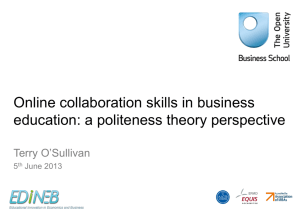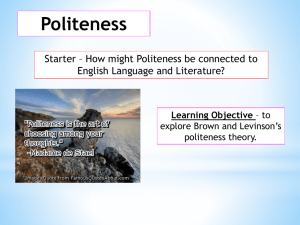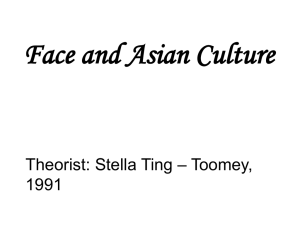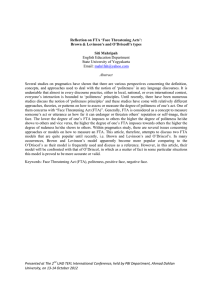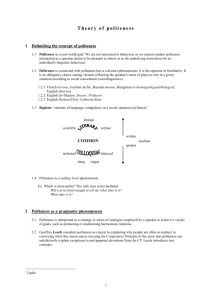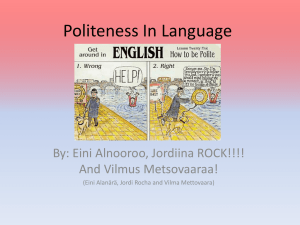POLITENESS
advertisement
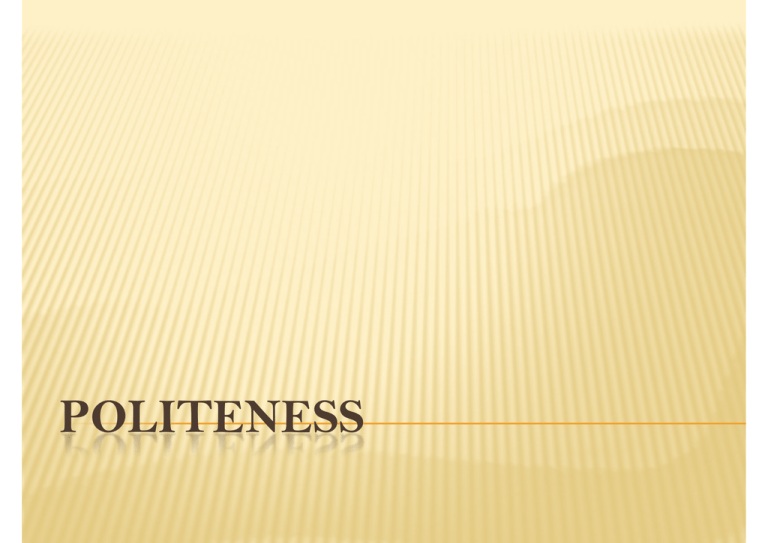
POLITENESS BASIC TERMS Face Politeness Negative and Positive Face Say something off and on record Strategies FACE Face means the public self-image of a person. It refers to that emotional and social sense of self that everyone has and expects everyone else to recognize. Within their everyday social interactions, people generally behave as if their expectations concerning their public self –image, or their face wants, will be respected. If a speaker says something that represents a threat to another individual’s expectations regarding self-image, it is described as a face threatening act. If a speaker say something to lessen the possible threat. This is called a face saving act. POLITENESS Politeness , in an interaction, can then be defined as the means employed to show awareness of another person’s face. […] the positive social value a person effectively claims for himself by the line others assume he has taken during a particular contact. Face is an image of self delineated in terms of approved social attributes – albeit an image that others may share, as when a person makes a good showing for his profession or religion by making a good showing for himself. (Goffman 1967: 5) via Bousfield, Derek.2008. Impoliteness in Interaction. Amsterdam: John Benjamins B.V., 56) Brown and Levinson (1987), subdivide ‘face’ into ‘Positive Face’ and ‘Negative Face’, (Brown and Levinson 1987: 62): – Negative face: the want of every ‘competent adult member’ that his/her actionsbe unimpeded by others. – Positive face: the want of every member that his/her wants be desirable to at least some others. NEGATIVE AND POSITIVE FACE A person’s negative face is the need to be independent, to have freedom of action, and not to be imposed on by others. A person’s positive face is the need to be accepted, even liked, by others, to be treated as a member of the same group, and to know that his or her wants are shared by others. In shorts, negative face is the need to be independent, and positive face is the need to be connected. SAY SOMETHING: OFF AND ON RECORD Off record: the statements have not been heard….. Hints. e.g. -Uh, I forgot my pen. -I wonder where I put my pen. On record: directly address the other as a means of expressing needs. e.g. - Give me a pen. -Lend me your pen. POSITIVE AND NEGATIVE POLITENESS A positive politeness strategy leads the requester to appeal to common goal, and even friendship, via expressions such as: How about letting me use your pen? Hey, buddy, I’d appreciate it if you’d let me use your pen. A negative politeness strategy---most typical form used is a question containing a modal verb such as: Could you lend me a pen?///? I am sorry to bother you, but can I ask for a pen or something? STRATEGIES The tendency to use positive politeness forms, emphasizing closeness between speaker and hearer, can be seen as a solidarity strategy. The tendency to use negative politeness forms, emphasizing the hearer’s right to freedom, can be seem as a deference strategy. POLITENESS PRINCIPLES Leech’s Politeness Principle (hereafter PP) states that with all other things being equal one should, ‘Minimise the expression of impolite beliefs, Maximise the expression of polite beliefs’ (Leech 1983: 81). Summarising further, Leech subdivides the PP into six maxims (which he later renames and expands as ‘constraints’ (2005)), as shown in Table 2, below. (Bousfield, Derek.2008. Impoliteness in Interaction. Amsterdam: John Benjamins B.V., 48) TABLE 2. LEECH’S (1983) POLITENESS MAXIMS AND SUB-MAXIMS (LEECH 1983: 32) Maxim/ Constraint Positive Politeness Negative Politeness I. Tact (a) Minimise cost to other [(b) Maximise benefit to other] II. Generosity (a) Minimise benefit to self [(b) Maximise cost to self] III. Approbation (a) Minimise dispraise of other [(b) Maximise praise of other] IV. Modesty (a) Minimise praise of self [(b) Maximise dispraise of self] V. Agreement (a) Minimise disagreement [(b) Maximise agreement between self and other] VI. Sympathy (a) Minimise antipathy between self and other [(b) Maximise sympathy between self and other. THE SUPERSTRATEGIES THAT BROWN AND LEVINSON CLAIM CAN BE DEPLOYED FOR POLITENESS WORK ARE: Bald on record politeness – The FTA is performed “[…] in the most direct, clear, unambiguous and concise way possible” (Brown and Levinson 1987: 69). In short, the utterance is maximally efficient with regards to Grice’s conversational maxims. 2. Positive politeness – The FTA is performed utilising strategies oriented towards redressing the positive face threat to the hearer. The linguistic output strategies include (Brown and Levinson 1987: 103–129): 1. Claim common ground – Notice, attend to H (his interests, wants, needs, goods) – Exaggerate (interest, approval, sympathy with H) – Intensify interest to H – Use in-group identity markers: in-group language or dialect, jargon, slang, contraction or ellipses – Seek agreement: safe topics, repetition – Avoid disagreement: token agreement, pseudo-agreement, white lies, hedging opinions – Presuppose/raise/assert common ground: gossip, small talk, point of view operations, presupposition manipulations – Joke Convey that S and H are co-operators – Assert or presuppose S’s knowledge of and concern for H’s wants – Offer, promise – Be optimistic – Include both S and H in the activity – Give (or ask for) reasons – Assume or assert reciprocity Fulfil H’s want for some X – Give gifts to H (goods, sympathy, understanding, cooperation) 3. Negative politeness – The FTA is performed utilising strategies oriented towards redressing the negative face threat to the hearer. The linguistic output strategies include (Brown and Levinson 1987: 129–211): Be indirect – Be conventionally indirect Don’t presume/assume – Question, hedge: hedge on illocutionary force, prosodic/kinesic hedges Don’t coerce H – Be pessimistic – Minimize the imposition, Rx – Give deference Communicate S’s want to not impinge on H – Apologize: admit the impingement, indicate reluctance, give overwhelming reasons, beg forgiveness – Impersonalize S and H: use performatives, imperatives, impersonal verbs, passive and circumstantial voices, replace the pronouns ‘I’ and ‘you’ by indefinites, pluralize the ‘I’ and ‘you’ pronouns, use point-of-view distancing – State the FTA as a general rule – Nominalize Redress other wants of H’s – Go on record as incurring a debt, or as not indebting H 4. Off-record – the FTA is performed ‘Off Record’, typically through the deploymentof an indirect illocutionary act which has more than one interpretation and, thus, allows for plausible deniability on the part of the utterer if the intended recipient takes offence at the face threat inherent in the utterance. The linguistic output strategies include (Brown and Levinson 1987: 211–227): Invite conversational implicatures: – Give hints – Give association rules – Presuppose – Understate – Overstate – Use tautologies – Use contradictions – Be ironic – Use metaphors – Use rhetorical questions Be vague or ambiguous: Violate the manner maxim: – Be ambiguous – Be vague – Over-generalize – Displace H – Be incomplete, use ellipsis 5. Don’t perform the FTA – The FTA, judged to be too threatening to the intended recipient, is, therefore, in the interests of social harmony, not performed. (Bousfield, Derek.2008. Impoliteness in Interaction. Amsterdam: John Benjamins B.V., 56-59).
